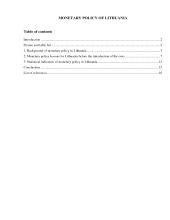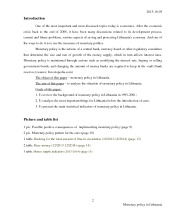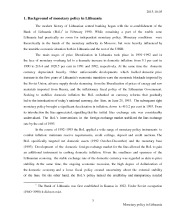Monetary Policy In Lithuania



Introduction. Picture and table list. Background of monetary policy in Lithuania. Monetary policy lessons for Lithuania before the introduction of the euro. Statistical indicators of monetary policy in Lithuania. Conclusions. List of references.
The object of this paper – monetary policy in Lithuania.
1. To review the background of monetary policy in Lithuania in 1991-2001;
2. To analyze the most important things for Lithuania before the introduction of euro;
3. To present the main
1 pic. Possible positive consequences of implementing monetary policy (page 9)
2 pic. Monetary policy pattern for the euro (page 10)
1 table. Backing for the total amount of litas in circulation (12/2013-12/2014) (page 13)
2 table. Base money (12/2013-12/2014) (page 14)
3 table. Money supply indicators (2013-2014) (page 15)
The transmission mechanism of the monetary policy from instruments to proximate targets such as money supply, exchange rate and liquidity in Lithuania’s case can be achieved only by implementing the monetary policy. The implementation of the monetary policy possibilities could: (see 1 pic.)
1 table. Backing for the total amount of litas in circulation (12/2013-12/2014) (outstanding amounts at the end of the period, EUR million)
2 table contains data on the base money in the period from 12/2013 to 12/2014.
3 table contains data on various money supply indicators in the period of 2013-2014. Below explanations on the indicators are given:
Base money – currency in circulation, credit institutions’ current accounts and required reserves.
The course of applying monetary policy in Lithuania was very unstable because Lithuania for a long period of time was a part of rouble zone and it began after Bank of Lithuania was re-established in 1990. Two important dates that changed nation's monetary policy were 1999 when guidelines for the application of the Bank of Lithuania monetary policy were published and 2001 when new law of the Bank of Lithuania came into the force;
Before the introduction of the euro, Lithuania had to adapt to the European Central Bank's methodology of developing the monetary policy and also to ensure the compliance with the criteria of the Maastricht Treaty (stability of macroeconomic indicators, related to inflation, government budget deficit, currency exchange rate and long temr interest rates);
Statistical indicators of monetary policy in Lithuania shows that from the end of 2013 till the end of 2014, the total amount of litas in circulation was not stable but increased totally by 25,59%; base money was growing constantly and increased totally by 72,65%; money supply indicators shows positive tendencies.
- Economy & Finance Papers
- Microsoft Word 105 KB
- 2015 m.
- English
- 16 pages (4095 words)
- Ilona
















